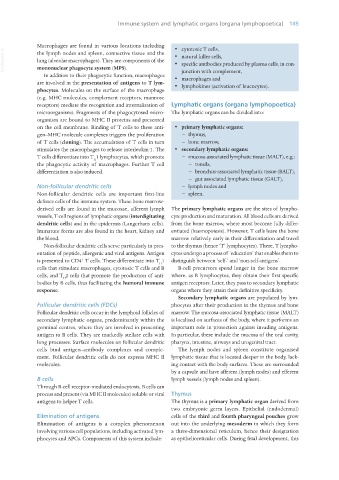Page 167 - Veterinary Histology of Domestic Mammals and Birds, 5th Edition
P. 167
Immune system and lymphatic organs (organa Iymphopoetica) 149
Macrophages are found in various locations including · cytotoxic T cells,
VetBooks.ir the lymph nodes and spleen, connective tissue and the · natural killer cells,
lung (alveolar macrophages). They are components of the
· specific antibodies produced by plasma cells, in con-
mononuclear phagocyte system (MPS).
junction with complement,
In addition to their phagocytic function, macrophages · macrophages and
are involved in the presentation of antigens to T lym- · lymphokines (activation of leucocytes).
phocytes. Molecules on the surface of the macrophage
(e.g. MHC molecules, complement receptors, mannose
receptors) mediate the recognition and internalisation of Lymphatic organs (organa lymphopoetica)
microorganisms. Fragments of the phagocytosed micro- The lymphatic organs can be divided into:
organism are bound to MHC II proteins and presented
on the cell membrane. Binding of T cells to these anti- · primary lymphatic organs:
gen–MHC molecule complexes triggers the proliferation − thymus,
of T cells (cloning). The accumulation of T cells in turn − bone marrow,
stimulates the macrophages to release interleukin-1. The · secondary lymphatic organs:
T cells differentiate into T 1 lymphocytes, which promote − mucosa-associated lymphatic tissue (MALT), e.g.:
H
the phagocytic activity of macrophages. Further T cell − tonsils,
differentiation is also induced. − bronchus-associated lymphatic tissue (BALT),
− gut associated lymphatic tissue (GALT),
Non-follicular dendritic cells − lymph nodes and
Non-follicular dendritic cells are important first-line − spleen.
defence cells of the immune system. These bone marrow-
derived cells are found in the mucosae, afferent lymph The primary lymphatic organs are the sites of lympho-
vessels, T-cell regions of lymphatic organs (interdigitating cyte production and maturation. All blood cells are derived
dendritic cells) and in the epidermis (Langerhans cells). from the bone marrow, where most become fully differ-
Immature forms are also found in the heart, kidney and entiated (haemopoiesis). However, T cells leave the bone
the blood. marrow relatively early in their differentiation and travel
Non-follicular dendritic cells serve particularly in pres- to the thymus (hence ‘T’ lymphocytes). There, T lympho-
entation of peptide, allergenic and viral antigens. Antigen cytes undergo a process of ‘education’ that enables them to
+
is presented to CD4 T cells. These differentiate into T 1 distinguish between ‘self-’ and ‘non-self-antigens’.
H
cells that stimulate macrophages, cytotoxic T cells and B B-cell precursors spend longer in the bone marrow
cells, and T 2 cells that promote the production of anti- where, as B lymphocytes, they obtain their first specific
H
bodies by B cells, thus facilitating the humoral immune antigen receptors. Later, they pass to secondary lymphatic
response. organs where they attain their definitive specificity.
Secondary lymphatic organs are populated by lym-
Follicular dendritic cells (FDCs) phocytes after their production in the thymus and bone
Follicular dendritic cells occur in the lymphoid follicles of marrow. The mucosa-associated lymphatic tissue (MALT)
secondary lymphatic organs, predominantly within the is localised on surfaces of the body, where it performs an
germinal centres, where they are involved in presenting important role in protection against invading antigens.
antigen to B cells. They are markedly stellate cells with In particular, these include the mucosa of the oral cavity,
long processes. Surface molecules on follicular dendritic pharynx, intestine, airways and urogenital tract.
cells bind antigen–antibody complexes and comple- The lymph nodes and spleen constitute organised
ment. Follicular dendritic cells do not express MHC II lymphatic tissue that is located deeper in the body, lack-
molecules. ing contact with the body surfaces. These are surrounded
by a capsule and have afferent (lymph nodes) and efferent
B cells lymph vessels (lymph nodes and spleen).
Through B-cell receptor-mediated endocytosis, B cells can
process and present (via MHC II molecules) soluble or viral Thymus
antigens to helper T cells. The thymus is a primary lymphatic organ derived from
two embryonic germ layers. Epithelial (endodermal)
Elimination of antigens cells of the third and fourth pharyngeal pouches grow
Elimination of antigens is a complex phenomenon out into the underlying mesoderm in which they form
involving various cell populations, including activated lym- a three-dimensional reticulum, hence their designation
phocytes and APCs. Components of this system include: as epithelioreticular cells. During fetal development, this
Vet Histology.indb 149 16/07/2019 14:59

